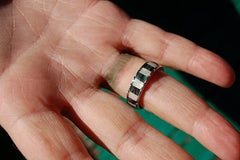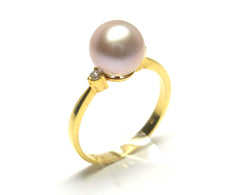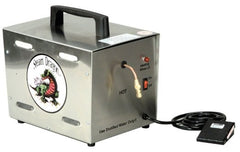News
Hollow Gold Chains Save You Money - Unless They Need To Be Repaired April 13, 2024 15:00
The price of gold is sky rocketing. Gold is mostly sold by weight. Hollow gold jewelry seems like a good value, but is it really?Wearing Jewelry - Especially Rings and Chains - 24/7 is NOT a good idea. April 17, 2023 13:12
Wearing your diamond ring 24/7 is really not a good idea.
Why Is My Ring Turning My Finger Black? May 1, 2018 13:25
We get this question from time to time. Mostly from women, but also from men once in a while. The answer can be quite complicated (sorry). It can be as simple as taking the ring off at night, but it can be very complex and involve medications or hand lotions.

The answer below was copied from one of our favorite trade magazines, InStore. This was in the April 2018 edition. It is an excellent summary of areas to investigate if your ring is causing a reaction:
"Here is some helpful information: What do you do with a customer who claims their rings are turning their finger black?
Ask her if she’s recently changed her choice of hand lotion or make-up. This is the most common cause of such smudging, as cosmetics often contain chemical compounds, which — astonishingly — are harder than the jewelry itself. When these hard compounds come in contact with jewelry metals, abrasion occurs, causing tiny particles of metal to break off as a black dust. When mixed with perspiration or other liquids, it results in the alarming black stain.
It’s also possible that a change in diet or even a new course of medication is resulting in a chemical reaction where perspiration and metal meet. If she is going swimming with her jewelry on, chlorine is another possible suspect. To prevent the smudging, suggest she avoid cosmetics that contain zinc oxide, titanium dioxide, ferric oxide and calamine.
Also, tell her to try removing the rings while applying cosmetics and cleaning her fingers with soap and water in areas that will be in contact with her jewelry. Finally, if the problem persists, suggest she consider having the inside of the bands coated with rhodium to prevent such a reaction."
InStore Magazine "Ask InStore" April 2018 edition
Public Service Announcement - Don't Wear Rings To The Gym January 9, 2018 15:53
Do NOT wear gold/silver/platinum rings to the gym.Taking Care of Your Pearl Jewelry May 25, 2016 11:38
Shout out to our favorite Californian, Elizabeth, for suggesting we put more "How to take care of your jewelry" information up here. Your wish is our command!

Good rule of thumb for pearl jewelry - especially necklaces, earrings, and bracelets: "Last On and First Off."
The nacre of the pearl is the outside part of the pearl we see and love. It is what gives the luster to pearls and provides the depth of color - think of the term pearlescence. Well, you want to put your pearls on AFTER you put on any make-up, hair treatment, and even perfume. That kind of material can build up on the pearls and a) ruin the luster or b) in extreme cases even damage the nacre by eating away at it.
At the end of the day, you want to remove your pearls BEFORE you start your ablutions for the same reasons. You don't want soap or some other cleaning product that may be harsh to come into contact with your pearls.

We often tell people to do the dishes with their wedding rings on - the hot soapy water disolves the oily residue that makes diamonds lose their sparkle.
If you have a pearl ring - NEVER do the dishes with it on. They way the vast majority of pearls are attached to rings (like the one above), and many earrings and pendants for that matter, is when the pearl is half-drilled and then attached to a post using expoxy. Even the best epoxy will loosen after exposure to water.
I cannot tell you the number of pearl rings I have seen over the years where there is nothing left of pearl's nacre. The seed pearl is still on the ring, but the good part with the luster and shine has been eaten completely away.
So - please keep ALL of your pearl jewelry our of water - even showers or baths. And because of chlorine in pools and even WORSE chemicals in hot tubs - never, ever, ever ever go in a pool or hot tub with your pearl jewelry on.
Bring Your Ring in For a Day at The Spa - $15 January 30, 2016 11:52
Your rings work hard to glamorize your hand - give them a Spa Day at Chimera Design.
We will start with an inspection of the ring. We will make sure the tips, prongs, channels, and bezels are in good shape for keeping your diamonds and gemstones secure in the mounting.
The it is off to the back room for an invigorating 2850 rpm session with our Handler Buffer. This will remove surface scratches and return your precious metal to a nice shine. Our jewelers rouge is especially formulated to clean and polish.

From there your ring will be transferred to our Branson 2510 heated ultrasonic where any dirt and debris will be gently shaken by the soothing 40kz sonic waves.

Then it is a short hop over to our 1300 watt Steam Dragon steamer for a purifying blast of vaporized distilled water at 90-125 psi. This will remove any residual jewelers rouge and gra-do!

A Quick Education About Colored Diamonds August 21, 2015 17:09
Colored Diamonds From The Laboratory
We have a line of colored diamond jewelry at Chimera.

The colored diamonds we sell (usually) are natural, white diamonds that have been changed into colored diamonds. There are three methods that can be used singly or in combination with each other depending on the color desired.
Electron Irradiation - a pulsed beam of electrons that will induce color into the diamonds is fired at them. The light absorbing pattern is changed and so is the color. Used alone, this process gives diamonds a blue or greenish blue color.
Annealment - To expand the range of colors, super heating them in an oxygen-free environment in temperatures 900 degrees and higher allows us to get other shades of color. The atomic structure of the diamonds rearrange, and a new palate of colors is possible.
High Pressure High Temperature (Hpht) - The HPHT process recreates the heat and pressure that creates diamonds initially in the Earth. Sophisticated machinery is programmed to accent conditions to get yellows, oranges, and greens.
There is a fourth method consisting of coating the diamond, which is used to create a truly pink color. The coating is done at the pavilion - the lower part of the diamond. This allows the color to shine through the entire diamond.

The first three treatments are more stable than the fourth. Diamonds that have been irradiated and/or annealed will not fade over time and they will wear like a normal diamond. The only caveat is that when being worked on by a jeweler, they need to be careful NOT to expose the diamond to heat in excess of 900 degrees which could occur when sizing a ring.
The HPHT method requires no caution of any kind.
The technology creating colored diamonds has moved forward tremendously in the last decade. When we first opened in 2002, treating diamonds was reserved for those very low on the clarity scale (I1 to I3) because the science was very in-exact as to the results. Sometimes they came out looking terrible. Blue ones could be all over the color spectrum and it was hard to create diamonds that were a good color match even when they were treated together.
Fast forward to the present day, and companies like Lotus Color can provide colored diamonds with better clarity (SI1-2) and with wonderful consistency. This makes it much easier to design and build colored diamond jewelry that is affordable and beautiful.

NATURAL COLORED DIAMONDS
They exist and they are extremely rare and costly. A 9.75 ct natural blue diamond (above) was auctioned in 2014 for 32.6 million dollars. Pink diamonds are found in Australia in very limited quantities and typically command prices in excess of what most of us can handle.
Typically a yellowish tint causes the price/value of a diamond to go down. That is true until the saturation of the yellow color reaches what GIA terms "Fancy" and then the price jumps up like a ROCKET!
Conclusion - creating colored diamonds in the lab is a wonderful way to make the long lasting beauty of colored diamond jewelry something that regular people can afford and appreciate. We are excited to offer colored diamond jewelry in our store and to you online.
Should I Wear My Jewelry In A Pool or Hot Tub? July 31, 2015 18:18 3 Comments
Information about the care, cleaning, and manufacture of fine jewelry.Swimming pools, hot tubs and your jewelry.

The short answer to the question above is: NO to the pool and NO-NO-DEFINITELY NOT to the hot tub.
A few words of caution about SWIMMING POOLS and HOT TUBS. We do not recommend that any fine jewelry be worn in public swimming pools or hot tubs. Chlorine is a corrosive chemical - it won't do any harm to diamonds, rubies, sapphires, and some other gemstones, but it is not good for your white or yellow gold to say nothing of sterling silver.
Chlorine can also discolor and/or prematurely wear out your watch - even watches rated to be underwater. (See our blog post on that subject: Watch Ratings)

Hot tubs are waaay worse than pools because in addition to harsh chemicals, you have the addition of high temperatures AND the pressure of the water coming out of the jets. We do not recommend that any jewelry or watches be worn in hot tubs. Even watches that are rated to go under water to some degree can be infiltrated by the water coming out of the jets.
Hot tubs are great for humans - they are a TERRIBLE environment for your jewelry and watches. Take the little bit of extra time to remove your jewelry and watches BEFORE you get in.
Kevin asked if it is safe to wear his titanium ring in a hot tub on a daily basis. My answer to that would be.....maybe. If the titanium has any kind of enameling or stone of any kind in it, then NO. If it is a plain band, there will probably NOT be a problem - but if it has any type of a finish on it, you might find that a daily dunking in the chemicals would change the appearance of even a titanium ring. Best bet - take it off - take it ALL off!!
I would make the same recommendation for those folks with tungsten or tungsten carbide rings. We sell them and I wear them and I would take mine off before spending time in a hot tub. Heat and chemicals wreck havoc!
The Importance of Cleaning and Maintaining Your Jewelry July 31, 2015 17:49
Information about the care, cleaning, and manufacture of fine jewelry.The importance of jewelry maintenance.
Jewelry Maintenance - this is a serious subject. For most people, a diamond ring represents the biggest jewelry investment they have. Most diamond rings - engagement, wedding, or anniversary rings - are worn 24/7/365. Just like anything else - your jewelry needs to be maintained - especially a ring on your finger.
When your ring is new - the diamond(s) is secured by prongs and tips.
The tips on the prongs come up over the edge of the diamond and help to hold it secure in the mounting. Over the years you put your hand (ring) in and out of your pockets, in and out of gloves, and generally wear the heck out of it. That is a good thing - but you should have your rings inspected at LEAST once a year. A competent jeweler can look at the condition of your ring and know if your diamond is secure in the mounting.
Look at the picture of the new ring - then compare the tips on it with the other examples. (These are actual rings that have come in our shop.) Tips and prongs can be replaced - for much less than the cost of a diamond! Most ladies will get 8-12 years wear - but we know ladies who wear tips down in 3 years and sometimes even quicker.
GET YOUR RINGS INSPECTED!!
We do not charge for inspection, nor do most jewelry stores. Let a pro take a look for you at least once or twice a year. It can save you big money to say nothing of the sentimental value.

This is a new ring. Notice the tips come up
over the edge of the diamond, holding it in place.

You can see how the tips have worn away,
this diamond is ready to fall out.

Another example. This diamond has a 6
prong head, but 3 of the 6 are GONE and
the other 3 are very thin. DANGER!!!

One last example - see how the end of this diamond is exposed and two of the other four prongs are essentially gone.